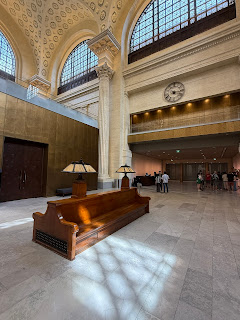When I was faced with the choice of touring the Senate or the House of Commons I chose Senate because it appeared first in the list. Once I learned on our walking tour that the Senate was currently being housed in their Beaux Art-style train station, I was really happy with my decision.
Unfortunately we had one tiny hurdle: I could not find the email with my free ticket in it.
I walked up to the ticket booth and asked if they could give send it to me again so I could have it scanned at the entrance. For some reason, they could not print my 3:20 ticket, but they could give me a ticket to their 3:30 tour, also in English, besides by that point we wouldn't be able to get past security in time for the tour. Though they couldn't print my 3:20 ticket, they could print the later one.
<insert eye roll>
Of course we got through security in time to watch the 25 people leave for the 3:20 tour, but as it was only an additional 10 minutes, we waited for our turn.
In the category of sometimes things work out, our tour only had one other couple in it and they hardly spoke the entire time. It felt as if Alexandre (who we later learned will be moving to Hackensack, New Jersey for a medical internship), was giving us a free private tour.
Here we go...
The train station was built from 1909 to 1912 in the Beaux Art style with 23 foot tall plaster columns made to look like marble, and much elegance. It was a train station from 1912-1966 when the trains were moved away from the center of the city. After that, it became a generic government office. In 2014 it was chosen as the site for the Senate to use during the 2019 planned renovations to Parliament Hill.
Lining the walls of the room we waited in are portraits of French kings. Prior to 1763, both Britain and France shared Canada. In this room is an art deco bench from the days when it was a train station. Two days later we saw a similar bench in the Railway Museum of Eastern Ontario.
Our tour began next to the original door to the senate lined with a representation of a flag from each of the ten provinces and three territories, and next to a bust of Queen Elizabeth, which bears the question when there will be one of King Charles. That, Alexandre said, is up to England. He did visit a couple of weeks ago to start the most recent session of Parliament. His image is already appearing on their coins, and will be on their 20$ bill in 2027.
There are many similarities between how the governments of the United States and Canada are structured. They are both bicameral legislatures with a small senate and a larger congress (House of Representatives vs. House of Commons). The differences end when it is explained Canada is still connected to England. Theirs is a constitutional monarchy with the governor general (in this case Mary Simon, the first indigenous person to hold the role) acting on behalf of the Crown. It is largely a ceremonial role.
The 105 senators sit in the red room. They are appointed to their role and hold it until the age of 75 when they are asked to retire. They must be Canadian citizens and have at least $4,000 in assets. A number that has remained unchanged since 1867.
Again, a big difference since in the United States senators are elected.
Seeing all the red chairs reminded me of our visit of Parliament in Canberra, Australia. Red represents the monarchy and is a more expensive color than the green used for the House of Commons.
In the far end of the room are three chairs. One each for the monarch and consort, and a third for the speaker of the senate. If the monarch is not in town, the governor general sits in the monarch's seat. His or her spouse does not sit in the consort's seat.
As parliament is opened, a speech is given from the throne by the king or governor general listing the agenda for the term and the promises they want to make. The usher of the black rod then heads to the door of the House of Commons and knocks three times to invite them. Traditionally this is done by walking down a hallway. I imagine it is very ceremonious. As the two are now meeting in different parts of town, they took a convoy of shuttle busses rather than walk the kilometer through the crowds.
Elections take place roughly every four years, but can be triggered sooner. The most recent election was on April 28.
Debate takes place on the floor in whatever language is most comfortable to the person speaking. Each place has instantaneous translation in English, French, and now some indigenous languages as there are nine (out of 105) indigenous senators. Being bi (or tri) lingual is not a requirement to serve.
We went to one of four committee rooms. Committees typically have between ten and twenty senators on them. Members from the public are invited to speak on their areas of expertise. Bills are read out loud and debated.










No comments:
Post a Comment